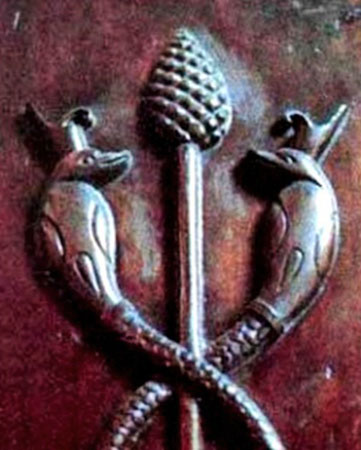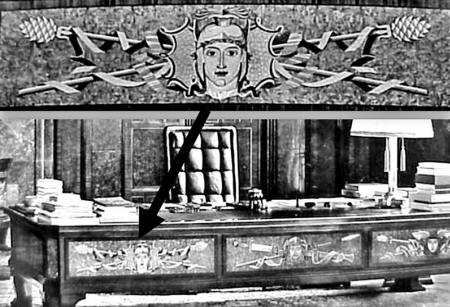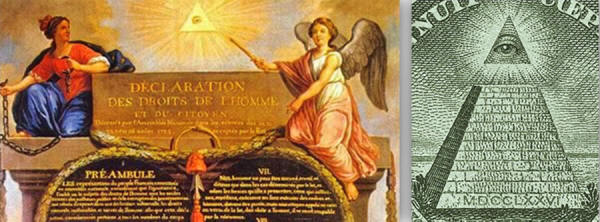The Pineal Gland – Occult Secrets Behind Pine Cone Art and Architecture

The pine cone symbol is one of the most mysterious emblems found in ancient and modern art and architecture. Few scholars realize it, but the pine cone alludes to the highest degree of spiritual illumination possible.
This was recognized by various ancient cultures, and the symbol can be found in the ruins of the,
Indonesians
Babylonians
Egyptians
Greeks
Romans
Christians,
…to name a few.
It also appears in the drawings of esoteric traditions like,
Freemasonry
Theosophy
Gnosticism
esoteric Christianity
The pine cone held the same meaning for all:
It symbolized a secret vestigial organ, the “pineal gland” or “Third Eye”, that we all possess.

Left: The magnificent ruins of Angkor Wat in Cambodia,
one of the most magical and spiritual places on earth,
are filled with pine cone symbolism.
Right: Antithetical animals flank an enlightened bodhisattva at Angkor Wat.
The majestic stone ruins of Angkor Wat are a marvelous sight to behold. Immense towers shaped like pine cones silhouetted against the sky rise out of the lush green jungle in a way that defies the imagination.
The pine cone shaped towers are often cited by scholars:
“The individual spires at Angkor have a…pine-cone profile…”
Benjamin Rowland, The Art and Architecture of India
The question, however, is the significance of the pine cones: it seems unlikely such a distinctive feature would appear with no rhyme or reason.
What is the significance of these pine cones to Angkor’s ancient buildings?
Also never explained is another Angkor Wat phenomenon called “antithetic animals.” In the example shown in the image above we see a pair of twin, symmetrical elephants facing each other, an image that is often glossed over or unexplained.
Interestingly, similar antithetical animal art appears on other famous ancient archaeological “pine cone” relics.
For example, at the ancient Roman pigna (Italian for pine cone) sculpture shown below, a massive bronze pine cone is flanked by twin antithetical peacocks.

Above: Built by the Romans, this 1st century Roman bronze sculpture,
called the “Pigna” (“pine cone”), was once an ancient fountain.
The Pigna sculpture sits in a Vatican courtyard called the Court of the Pine Cone, and is today considered the largest pine cone statue in the world.
The parallels do not end there, however: the Egyptian staff of Osiris (c. 1224 BC) not only depicts antithetical cobras but has them rising up to meet at a pinecone:

Above: The pine cone staff of Osiris.
Egyptian Museum in Turin, Italy, 1224 BC.
What is the symbolic meaning of these pine cones, and how do the antithetical animals factor into their overall meaning?
What is the deeper secret these apparently inscrutable images hide?
Third Eye / Pineal Gland
The answer to this is that pine cones, throughout history, have symbolized the “pineal gland”, or “Third Eye”, and by association the esoteric act of awakening it.
This gland is said to lie at the geometric center of the brain, and considered by some as the biological Third Eye; the French philosopher Descartes famously referred to the pineal gland as the Seat of the Soul.
The pineal gland is given the following definition in Webster’s Ninth New Collegiate Dictionary:
“A small usu. conical appendage of the brain of all craniate vertebrates that in a few reptiles has the essential structure of an eye, that functions in some birds as part of a time-measuring system, and that is variously postulated to be a vestigial third eye, an endocrine organ, or the seat of the soul…”

Above: The pineal gland is shaped like a tiny pine cone, hence its name.
The pine cone symbolism is not lost on ancient cultures; in India, Hindu tradition teaches followers to awaken the Third Eye by activating their “seven chakras”.
It is an ancient exercise, still practiced today, called Kundalini Yoga; it is claimed to directly affect human consciousness, develop intuition, increase self-knowledge, and unleash one’s creative potential.
Interestingly, the esoteric symbol of kundalini yoga is the caduceus- a symbol that features two antithetical serpents.

Left: The caduceus staff, carried by Hermes in Greek mythology.
In ancient Rome it was depicted in the left hand of Mercury.
Right: A visual representation of the practice of Kundalini yoga,
the ultimate goal of which is to awaken the Third Eye hidden in the human forehead.
Kundalini is the spiritual energy or life force present in every human being, located at the base of the spine.
To awaken the Third Eye, the kundalini energy must be summoned to the forehead, where it expands and thus awakens the Third Eye. The energy is said to travel along the ida (left) and pingala (right), up the central pole or sushumna.
This is the process esoterically depicted by the caduceus symbol of two antithetical snakes spiraling up a central staff.
“…the caduceus, the rod of power…In India it is a stick of bamboo with seven knots… which represents the spinal column with its seven centers or chakras…
It also indicated the spinal cord…while the serpents were symbolical of the two channels called in Eastern terminology Ida and Pinagala; and the fire enclosed within it was the serpent-fire which in Sanskrit is called kundalini.”
C.W. Leadbeater, Freemasonry and its Ancient Mystic Rites
Thus, antithetical animal art associated with the pine cone,
twin elephants in Indonesia
twin peacocks in Rome
twin serpents in Egypt,
…is really an allusion to the ida and pingala channels (the antithetical twin serpents on the caduceus).
The central sushumna is, in turn, symbolized by the third, centered drawing (often a pine cone) which on the caduceus is the main rod running north south. Many ancient cultures incorporated images of the pine cone into their spiritual art and architecture, and they all also created antithetical animal art.
Pagan gods of Babylon, Egypt, Mexico and Greece were associated with the pine cone, and the staffs of these gods were often adorned with the pine cone.

Left: Sumerian God Marduk with pine cone in hand.
Right: Dionysus, the Romans Bacchus, carried a “Thyrsus” topped with a pine cone.
Even the natural behaviors of the pine cone have an esoteric meaning:
as it ripens, the pine cone slowly opens to release its mature seeds.
This process is symbolic of the expansion of consciousness that accompanies the opening of the pineal gland and the awakening of the Third Eye.
The metaphor is a valuable and stimulating mental lesson of an esoteric phenomenon that cannot otherwise be seen or explained since it occurs inside the brain:

Left: Bronze pine cone symbol in Aachen cathedral in Aachen, Germany.
Middle: Roman pine cone statue in the Piazza Venezia, Italy.
Right: Ripening pine cones.
Readers familiar with Eastern religions will recall the Third Eye as having a long history in India, China, and Southeast Asia, where the religious traditions of Hinduism, Buddhism and Taoism hold sway.
More than a “religious” idea, the Third Eye is an archaic “spiritual” custom that transcends religions.
It is known variously as “urna” and “trinetra,” and often marked by a dot in the middle of the forehead between the two eyes.

Above: The Third Eye between the eyebrows of the Buddha.
Awakening his Third Eye permitted the Buddha
to understand the forces of existence
and their manifestation in the chain of causality.
The Third Eye has been called by various names throughout history, including the,
“inner eye”
“mind’s eye”
“eye of the soul”
“eye of reason”
The portrait of a single “Eye” is, in fact, an archetypal image that stretches back many thousands of years in human history.
It appears again and again in myths, sculptures, engravings, and paintings in ancient cultures across the world. It was often depicted throughout ancient Egypt as a single disembodied Eye, the Eye of Ra:

The Eye of Ra,
a disembodied Eye signifying the Third Eye of illumination.
The Third Eye was commonly described by ancient mystics who experienced the divine light.
“.. in every man there is an Eye of the soul which… is far more precious than ten thousand bodily eyes, for by it alone is truth seen… The Eye of the soul… is alone naturally adapted to be resuscitated and excited by the mathematical disciplines.”
Plato, Republic
A superficial “tapping” of the Third Eye is not difficult.
Close your eyes and, without moving them, “look” at an object you know is close to you. You are seeing with your Third Eye. To elevate spirituality and awaken dormant powers, the Eye must be turned inward.
Western occult tradition agrees with ancient Eastern texts affirming that turning the Eye inward endows us with:
higher consciousness
a deeper understanding of life and death
a newfound ability to control the future
a sense of peacefulness and bliss
extrasensory, clairvoyant, intuitive and psychic abilities
expanded perception
enhanced capacity for self-healing
stress reduction
calmness and clarity
newfound sensitivity
Mystery writer Stephen King‘s ‘The Shining’ touched on this concept.
In King’s novel, “shining” meant tapping one’s higher psychic powers. Unfortunately, today ideas like the Third Eye and related mystical and/or esoteric concepts are frowned upon, pejoratively labeled “the occult.”
The question, however, is why the West has been so ill-informed of this Third Eye and its unlocking even as the Eastern traditions have incorporated them into their practices.
The answer to that is the rise of Christianity in the west; the practice and idea of an “inner god” or “Third Eye” to awaken runs afoul of traditional Christian teachings.
These wisdoms, forced underground, became the origins for secret societies that passed on these esoteric wisdom; one of these societies was the Freemasons.
Third Eye In The Masonic Triangle
In modern times, famous authors, painters and poets have described the Third Eye and pineal gland as being nothing less than the “lost secret” of Freemasonry.
In his 1918 book, The Wonders of the Human Body, Dr. George Washington Carey tells us:
“…the All-seeing eye… This is the eye of freemasonry, the third eye. While I am credibly formed that few Masons understand their own symbols, the fact remains that they use them…”
Dr. George Washington Carey, The Wonders of the Human Body
In her fascinating 1924 book, Mystic Americanism, the obscure American author Grace Morey explained:
“The All-Seeing Eye… also emblematic of the pineal gland or third eye of the human being… has been found amid the ruins of every civilization upon the globe, thereby attesting the fact of a universal religion over all the earth at some remote period.
As we now restore this universal religion, we set the All-Seeing eye upon the pyramid.”
Grace MoreyMystic Americanism
It comes as no surprise, then, that pine cones appear regularly throughout Masonic decoration.
They are depicted in Masonic art, they hang from the ceilings of Masonic Lodges, and they are etched in stone on Masonic-constructed buildings throughout the world.
A large Masonic design on the side of the Whitehall Building in the New York Financial District depicts two enormous intertwining snakes spiraling up to a pinecone (which is striking similar to the Staff of Osiris).

Above: A caduceus depicting a pine cone
appears on the Whitehall Building in New York City.
Pine cones also adorn ritual instruments used by Freemasons inside Masonic lodges:
“The tops or points of the [Masonic] rods of deacons are often surmounted by a pine-cone or pineapple.”
Albert Mackey
“Operative Masonry, in the fullest meaning of that term, signifies the process by which the Eye…is opened.
E.A. Wallis Budge has noted that in some of the papyri illustrating the entrance of the souls of the dead into the judgment hall of Osiris the deceased person has a pine cone attached to the crown of his head.
The Greek mystics also carried a symbolic staff, the upper end being in the form of a pine cone, which was called the thyrsus of Bacchus. In the human brain there is a tiny gland called the pineal body, which is the sacred eye of the ancients, and corresponds to the third eye of the Cyclops.
Little is known concerning the function of the pineal body, which Descartes suggested (more wisely than he knew) might be the abode of the spirit of man.
As its name signifies, the pineal gland is the sacred pine cone in man – the eye single…”
Manly P. Hall, Secret Teachings of All Ages
The Third Eye has been hidden in plain sight in the West, masked as the term “all seeing eye” and superficially said to be the eye of the Jewish deity.
For this reason, Masons refer to it as the “all-seeing eye of God”, when in reality it’s the awakened Third Eye.

Masonic Lodge, Prague 18th Century,
depicting a Third Eye inside a luminous triangle.
The term “all-seeing eye” in and of itself is indeed correct; but it’s not the all-seeing-eye of the Hebrew ‘God’; it is the all-seeing eye of you, the pineal gland that we all have.
Many highly trained and educated Masons who lived during the 20th century, including several noted authors and scholars, were convinced that the all-seeing Eye was not the Eye of the Bible’s God, and that the modern system of Freemasonry we’ve inherited, based on the Hebrew Bible, is in fact corrupted.
It is interesting to note that the famous American Author and Freemason Mark Twain, writing in 1899, referred to the All Seeing Eye not as the Eye of some distant heavenly deity or “old man upstairs,” but as a tangible gift that any person can use:
“The common eye sees only the outside of things, and judges by that, but the ‘all seeing eye’ pierces through, and reads the heart and the soul, finding there capacities which the outside didn’t indicate or promise, and which the other kind couldn’t detect.”
Interestingly, there is evidence that Hitler was aware of and understood pine cone symbolism.
One of the front panels on his desk displays clear pine cone symbolism:

Picture of Hitler’s desk. See the Left panel.
A deity is flanked by staffs at the end of which are a pine cone.
Adolf Hitler believed in the Third Eye. This fact is affirmed by Hermann Rauschning, the former National Socialist Senate President of Danzig.
In Hitler Speaks (London, 1939), Rauschning wrote:
“To have ‘magic insight’ was apparently Hitler’s idea of the goal of human progress… There was the eye of the Cyclops, or median eye, the organ of magic perception of the Infinite, now reduced to a rudimentary pineal gland.
Speculations of this sort fascinated Hitler, and he would sometimes be entirely wrapped up in them.”
Hermann Rauschning
It seems that, almost 100 years ago, Hitler knew things about the Third Eye that most Americans are only now starting to rediscover.
The Third Eye can be seen above the French Declaration of Human Rights in a 1789 painting, and is on the back of the one dollar bill; it floats above an Egyptian pyramid, itself a clear and obvious Masonic image:

Left: The Third Eye in the triangle is visible above the French Declaration of Human Rights.
Right: The Third Eye in the triangle above a truncated pyramid
on the reverse of the Great Seal of the United States.
Is it possible, then, that the pineal gland has been overlooked in Western society intentionally, so as to rob the masses of its power?
Is it possible that the Third Eye is the lost secret of authentic Freemasonry, lost at some point in the mid 1800s?
To Conclude
The pine cone symbol, then, alludes to the Third Eye: it abounds in ancient art and architecture, a symbolic representation of our now-dormant window to the world.
While knowledge of the Third Eye and the practice of awakening the Third Eye continued strong in the East, it began to die in the West at the start of Christianity.
Consequently, Secret Societies like the Freemasons were established to protect Third Eye knowledge, initiate new members into its wisdom, and keep the practice alive.
This explains why the image of a single Eye is common to Western Secret Societies, whose constituents possessed exceptionally philosophical, active, creative, and spiritual minds.
A single Eye is one of the supreme and sacred emblems in Freemasonry.
The Third Eye seems strange, even downright alien to us in the West, even today, despite our living in the “information age” of globalization. The fact that the Third Eye is so unknown, so strange and so alien to our way of thinking is something of an enigma.
The reason is because there seems to have always been, and there continues to be, a conscious effort to conceal it by a powerful elite who don’t want the masses to discover its secrets.



 Creators of mankind
Creators of mankind Description of “Tall white aliens”
Description of “Tall white aliens” Where they came from?
Where they came from? About hostile civilizations
About hostile civilizations The war for the Earth
The war for the Earth “Tall white aliens” about eternal life
“Tall white aliens” about eternal life Video: “Nordic aliens”
Video: “Nordic aliens” Aliens
Aliens Alien encounters
Alien encounters The aliens base
The aliens base UFO
UFO Technology UFO
Technology UFO Underground civilization
Underground civilization Ancient alien artifacts
Ancient alien artifacts Military and UFO
Military and UFO Mysteries and hypotheses
Mysteries and hypotheses Scientific facts
Scientific facts


















